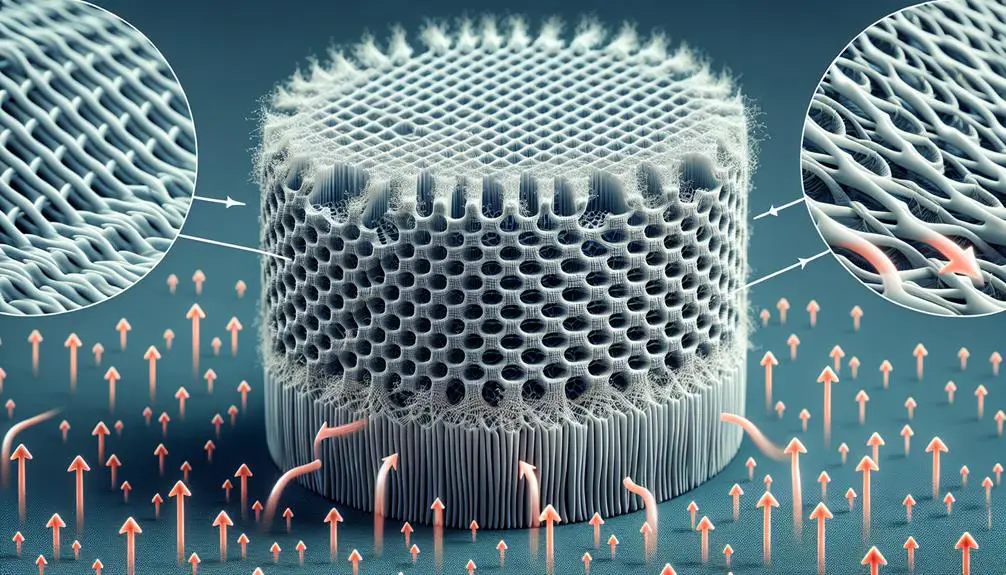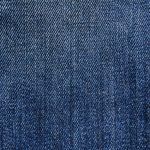You might not realize that the breathability of a fabric isn't just about how airy it feels against your skin. It's actually a complex interplay of fabric structure, fiber composition, and weaving techniques. Natural fibers like cotton and wool naturally excel, while synthetic materials are engineered for ideal airflow. This science guarantees fabrics can regulate temperature and moisture, providing comfort in various conditions. Curious about how these elements come together to create the perfect fabric for your needs? Let's explore the details and uncover what makes a fabric truly breathable.
Table of Contents
Key Takeaways
- Breathability in fabrics allows air and moisture to pass through, regulating temperature and moisture.
- Natural fibers like cotton and wool excel in breathability due to their fiber structure.
- Fabric breathability is enhanced by open-weave structures and advanced weaving techniques like 3D weaving.
- Moisture-wicking properties in synthetic materials like polyester improve comfort and moisture management.
- Breathable fabrics help maintain optimal thermal balance by facilitating air circulation and moisture escape.
Definition of Breathability
Breathability in fabrics refers to the ability of the material to allow air and moisture to pass through it. This capability is essential for maintaining comfort, especially during physical activities. When you understand the breathability definition, you'll see that it directly impacts fabric functionality, dictating how well a garment can regulate temperature and moisture.
In your pursuit for mastery of fabric technology, note that breathability isn't just about letting air in. It's also about efficiently managing sweat by moving moisture away from your skin to the fabric's exterior. This dual function prevents overheating and keeps you dry, thereby enhancing overall comfort. If you've ever felt sticky and uncomfortable in certain clothes, it's likely due to poor breathability.
To truly appreciate the science behind it, think about the fabric's structure. Materials with a more open weave tend to offer better breathability. Conversely, tighter weaves may restrict airflow, reducing the fabric's overall effectiveness.
You'll find that natural fibers like cotton and linen generally excel in this area, while synthetic fibers are often engineered to enhance these properties. Mastering the breathability definition and understanding fabric functionality will allow you to make more informed choices in your pursuit for the best comfort.
Key Factors in Breathable Fabrics
To choose the best breathable fabrics, you need to understand the key factors that influence their performance. The first factor is moisture-wicking capability. Fabrics that efficiently pull moisture away from your skin help maintain comfort and prevent microbial growth. This attribute is especially vital in activewear and outdoor gear, where sweat can create a breeding ground for bacteria.
Next, consider the fabric's breathability rating. This rating measures how well air can flow through the material, ensuring you stay cool and dry. Fabrics with high breathability ratings are excellent for warm climates and high-intensity activities.
Odor control is another crucial factor. Breathable fabrics that offer superior odor control often incorporate antimicrobial treatments. These treatments inhibit the growth of bacteria responsible for unpleasant smells, keeping your garments fresher for longer periods.
Durability also plays a significant role. A breathable fabric should withstand repeated use and washing without losing its performance characteristics. Look for materials that retain their moisture-wicking and breathability properties over time.
Natural Vs. Synthetic Materials
When choosing between natural and synthetic materials, you'll find distinct differences in their breathability and overall performance. Natural fibers like cotton, wool, and linen excel in breathability, allowing air to circulate freely and moisture to escape, which keeps you cool and comfortable.
On the other hand, synthetic materials such as polyester and nylon often trap heat and moisture, making them less breathable, though advancements have been made to improve their performance.
In terms of durability comparison, synthetic fabrics generally outlast their natural counterparts. Synthetics are engineered to resist wear, tear, and environmental factors like UV rays, giving them a longer lifespan.
Natural fibers, while comfortable and breathable, can degrade faster with frequent use and washing, which may not be ideal for high-intensity activities or long-term use.
Environmental impact is another essential consideration. Natural fabrics are biodegradable and often produced with fewer chemicals, making them more environmentally friendly. However, their cultivation can involve significant water and land use.
Synthetic fabrics, though durable, are derived from petrochemicals and contribute to microplastic pollution, posing long-term environmental challenges. Balancing these factors will guide you in making a more informed choice.
Weaving Techniques
Different weaving techniques can greatly influence a fabric's breathability and overall comfort. When you explore innovative weaves, you'll find they offer a remarkable range of benefits.
For instance, open-weave structures like mesh allow air to circulate freely, enhancing breathability significantly. You might also encounter advanced technologies like 3D weaving, which strategically places yarns to create channels for airflow, ensuring the best ventilation.
Understanding these techniques helps you appreciate how they contribute to sustainability. Eco-friendly options often use weaving methods that minimize waste and energy consumption.
For example, zero-waste weaving techniques can produce garments with minimal leftover material, directly supporting environmental goals.
Your knowledge of weaving can also guide you toward fabrics that balance breathability and durability. Twill weaves, with their diagonal patterns, offer a robust yet breathable option for everyday wear.
Conversely, plain weaves provide a lightweight and airy feel, ideal for hot climates or active pursuits.
Role of Fiber Structure
When considering breathability, you'll find that the structure of the fibers plays an essential role. Natural fibers like cotton often allow more airflow compared to synthetic fibers, which can trap heat.
Additionally, the density of the fibers affects how easily air passes through the fabric, directly impacting comfort.
Natural Vs. Synthetic Fibers
The unique structure of natural fibers like cotton and wool offers superior breathability compared to most synthetic fibers. The intrinsic fiber properties of natural materials allow for better moisture management, as they possess a natural ability to wick away sweat and permit airflow.
Cotton fibers, for instance, have a hollow core that enables them to absorb moisture and release it quickly, keeping you dry and comfortable. Wool, on the other hand, has a crimped structure that creates tiny air pockets, enhancing insulation and breathability simultaneously.
When considering environmental impact, natural fibers generally have a smaller footprint. Cotton and wool are biodegradable and renewable, making them more sustainable options. In contrast, synthetic fibers like polyester and nylon are derived from petrochemicals, leading to higher carbon emissions and slower decomposition rates. These synthetic fibers often trap heat and moisture, reducing overall comfort and breathability.
Understanding the role of fiber structure in breathability helps you make informed choices. Opting for natural fibers not only enhances your comfort but also reduces your environmental impact. This knowledge empowers you to select fabrics that align with both your performance needs and sustainability goals.
Fiber Density Impact
Building on the benefits of natural fibers, fiber concentration also plays a significant role in determining fabric breathability. When you consider fiber structure, the arrangement and concentration of these fibers directly impact how air flows through the fabric. Lower fiber concentration generally means less airflow resistance, allowing for better breathability. Conversely, higher fiber concentration can restrict airflow, making the fabric less breathable.
To understand the impact of fiber concentration on breathability, consider these factors:
- Airflow Channels: The spaces between fibers act as channels for air to pass through. More spacious channels (lower fiber concentration) promote better ventilation.
- Moisture Management: Fabrics with lower fiber concentration tend to manage moisture better by allowing sweat to evaporate quickly, keeping you dry.
- Thermal Regulation: Breathable fabrics with ideal fiber concentration help regulate body temperature by facilitating better air circulation.
- Comfort: Reduced airflow resistance in fabrics with lower fiber concentration translates to increased comfort, especially during intense physical activity.
Moisture-Wicking Properties
You'll find that a fabric's composition greatly impacts its moisture-wicking properties. Synthetics like polyester often excel in this area, especially in humid conditions.
Understanding these characteristics will help you choose the best materials for breathable and comfortable clothing.
Fabric Composition Impact
When selecting a fabric for its breathability, you'll find that the composition greatly affects its moisture-wicking properties. Different materials handle sweat and moisture in diverse ways, impacting both fabric durability and moisture management.
Natural fibers like cotton offer comfort but often lack in thermal regulation and moisture-wicking capabilities. Synthetic fibers, on the other hand, excel in these areas, providing enhanced moisture management and quick drying times.
Consider these four fabric types to understand their impact on breathability and moisture-wicking properties:
- Cotton: Highly breathable and comfortable but retains moisture, making it less effective in moisture-wicking.
- Polyester: Offers excellent moisture-wicking properties and durability, making it ideal for high-intensity activities.
- Wool: Natural thermal regulation properties and good moisture-wicking capabilities, though it can be less durable.
- Nylon: Strong and durable with good moisture management, yet sometimes less comfortable against the skin.
When selecting a fabric, balance your priorities. If comfort and breathability are paramount, cotton might be your go-to. For rigorous activities requiring superior moisture-wicking and durability, choose polyester or nylon. Wool serves well in cooler climates, thanks to its thermal regulation.
Choose wisely, and you'll master the art of fabric selection for best breathability.
Performance in Humidity
Understanding how fabrics perform in humid conditions is vital to choosing materials with ideal moisture-wicking properties. When you're in a humid environment, effective moisture management becomes essential.
Fabrics that excel in moisture-wicking draw sweat away from your skin, aiding in sweat absorption and evaporation. This process not only keeps you dry but also enhances overall fabric performance.
You'll want to focus on materials designed for best fabric breathability. Synthetic fibers like polyester or nylon are engineered to wick moisture efficiently. They pull sweat through the fabric to the outer surface, where it evaporates quickly. Natural fibers like merino wool also offer excellent moisture-wicking properties while maintaining breathability.
Consider the weave and finish of the fabric as well. A tighter weave might restrict breathability, impacting moisture management negatively. On the other hand, fabrics with a looser weave can enhance air circulation and improve sweat absorption.
For high-intensity activities or prolonged exposure to humid conditions, look for fabrics treated with moisture-wicking finishes. These treatments boost the material's ability to manage moisture and keep you comfortable.
Impact on Body Temperature
Breathable materials help regulate your body temperature by allowing air to circulate and moisture to escape. When you're active, your body produces sweat to cool down. Breathable materials facilitate sweat evaporation, which is essential for body heat regulation.
Here's how it works:
- Sweat Evaporation: When sweat evaporates from your skin, it takes heat with it, cooling your body. Breathable materials enhance this natural process.
- Air Circulation: These materials allow air to flow freely through the fabric, increasing the efficiency of sweat evaporation and reducing heat buildup.
- Moisture Wicking: Advanced breathable materials often incorporate moisture-wicking properties, pulling sweat away from your skin and dispersing it across the fabric's surface for faster evaporation.
- Thermal Balance: By managing both sweat and air flow, breathable materials help maintain an optimal thermal balance, preventing overheating and keeping you comfortable.
Mastering the science of breathability in fabrics means understanding these mechanisms.
Whether you're running a marathon or handling a busy day, the right fabric ensures you stay cool and dry. Choose materials that enhance sweat evaporation and body heat regulation for peak performance and comfort.
Testing Breathability
To ensure fabrics truly improve sweat evaporation and body heat regulation, you need reliable methods for testing breathability. There are several key techniques that offer detailed measurements.
One such method is the( MVTR) Moisture Vapor Transmission Rate test. This test quantifies how much moisture vapor passes through a fabric over a specific period, offering insights into its breathability.
Another vital method is the sweating guarded hotplate test, which simulates human skin conditions. It measures the fabric's ability to let moisture escape while maintaining thermal comfort. This test provides a thorough understanding of how a fabric performs in real-world scenarios.
In addition to these tests, advanced fabric innovation has introduced dynamic moisture management testing. This method assesses how fabrics handle moisture in different states, from liquid to of vapor. It's essential for evaluating performance fabrics meant for athletic wear or outdoor activities.
Choosing the Right Fabric
Selecting the right fabric hinges on understanding its breathability, durability, and comfort. When it comes to fabric selection, you need to weigh these factors carefully to make sure you get the best performance for your needs. Here's how you can make an informed choice:
- Breathability: Choose fabrics like cotton or linen, which allow air to circulate freely, keeping you cool and reducing moisture buildup.
- Durability: Look for materials like nylon or polyester that withstand wear and tear, making them ideal for active wear or outdoor use.
- Comfort: Consider the feel of the fabric against your skin. Soft, natural fibers are typically more comfortable for everyday wear.
- Purpose: Match the fabric to its intended use. Lightweight, breathable fabrics are best for hot climates, while heavier, insulated materials are suited for cold weather.
Comfort considerations are paramount when selecting fabrics. Think about how the fabric will interact with your body throughout the day. Will it wick away sweat? Is it soft enough to prevent irritation?
Frequently Asked Questions
How Does Fabric Breathability Affect Skin Health?
Fabric breathability directly impacts your skin health by enhancing skin hydration and moisture control. When fabrics breathe well, they prevent excess moisture, reducing irritation and promoting a balanced, healthy skin environment.
What Are Common Myths About Breathable Fabrics?
You might believe breathable fabric misconceptions like "all natural fibers are breathable" or "breathable means waterproof." The truth about breathable textiles is more nuanced; not all natural fibers breathe well, and breathability doesn't equal waterproofing.
Can Fabric Breathability Improve Athletic Performance?
Yes, fabric breathability can improve athletic performance. You'll experience better sweat absorption and moisture wicking, which enhances comfort and temperature regulation, allowing you to focus more on your performance and less on distractions.
How Does Breathability Impact the Environmental Footprint of a Fabric?
Have you considered how fabric breathability affects environmental impact? Breathable textiles often use advanced technologies promoting sustainability. By choosing breathable fabrics, you're not just enhancing comfort; you're also contributing to a more sustainable future.
Are There Any Innovations in Improving Fabric Breathability?
You'll find exciting innovations like nanotechnology applications and moisture-wicking technology enhancing fabric breathability. These advancements guarantee superior moisture management, keeping you comfortable while contributing to the fabric's overall performance and sustainability.
- What Are the Best Fabrics for Chinos? A Material Deep Dive - June 20, 2025
- Metal Fabrication Companies in China: An Outsourcing Guide - June 20, 2025
- The Process of Custom Fabric Printing in China Explained - June 20, 2025





